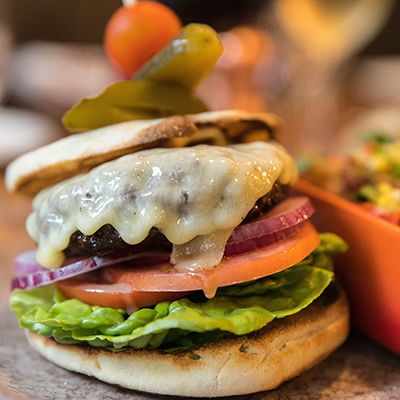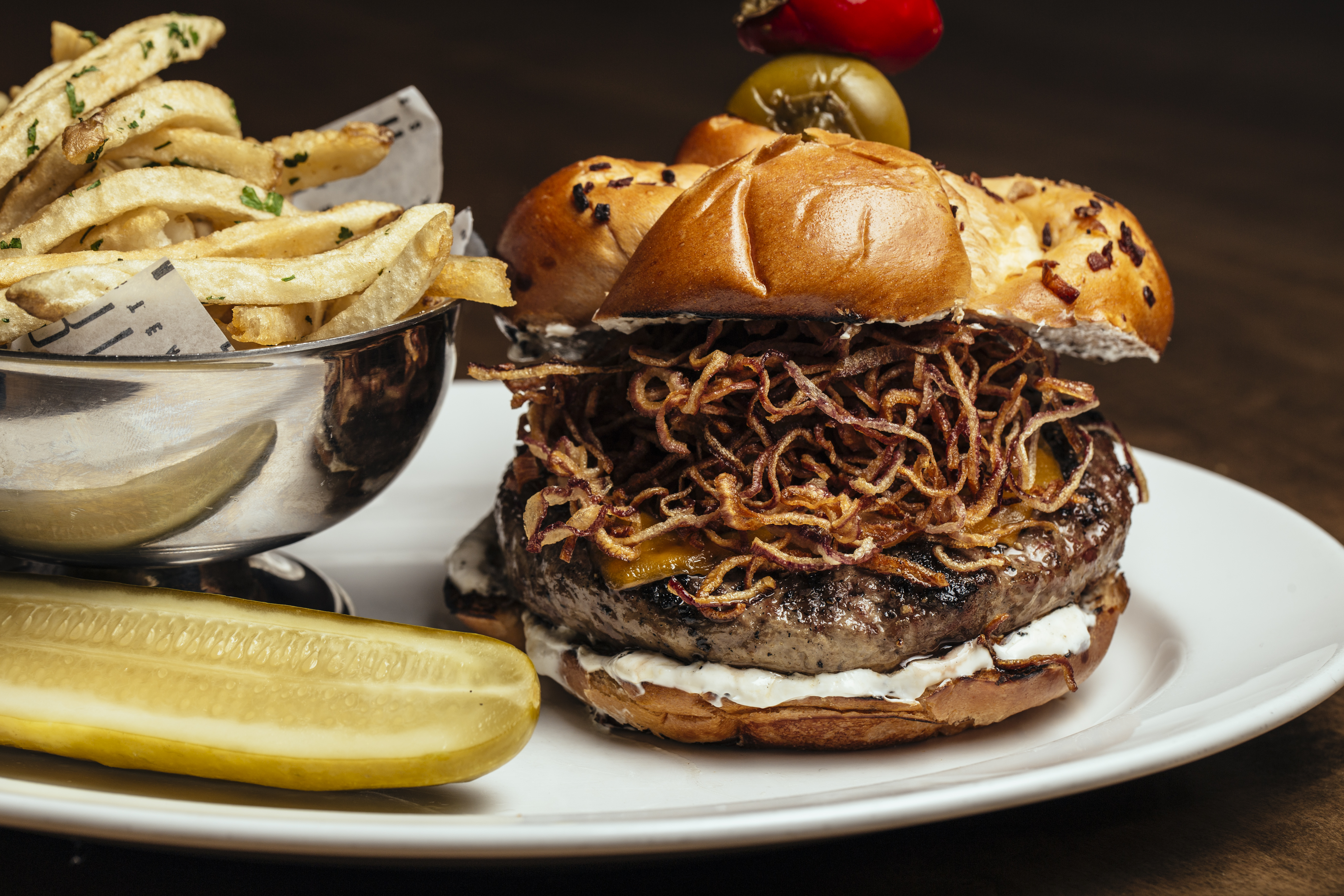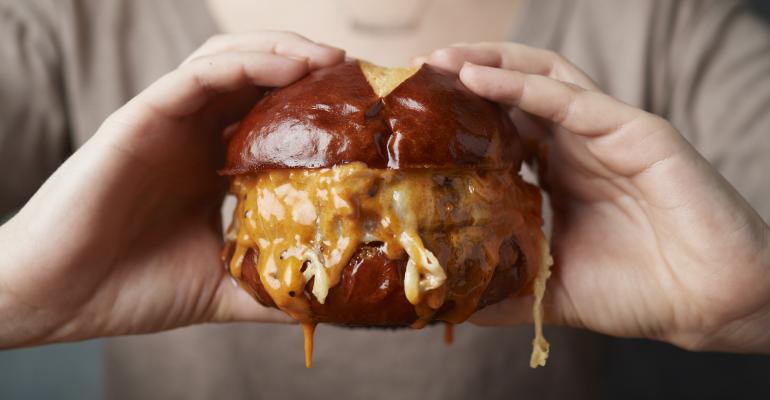Many steak aficionados like their meat to be dry-aged. Hanging beef under refrigeration for a few weeks results in more concentrated flavor, tenderer meat, and a certain mild gaminess that appeals to a lot of steakhouse diners.
But of course with steak comes meat and fat trim, and some chefs are making that into burgers, either as a byproduct of their own steak preparations or, increasingly, provided by specialty meat purveyors specifically for burgers.
The result is sandwiches with heftier beef flavor that can command significant price tags.
Some steakhouses, probably most famously Peter Luger in Brooklyn, N.Y., have been offering dry-aged burgers for years, but it’s catching on elsewhere, too.
Steak expert David Burke serves burgers made with dry-aged beef at several of his restaurants, including David Burke Tavern in New York City and Red Horse by David Burke in White Plains, N.Y.
He ages the beef himself in rooms lined with his Himalayan pink salt for 30-40 days. Most of the meat is cooked as steak, of course, but he saves the trim for burgers. The result is meat with less water than unaged beef, and he said there are several benefits to that: The flavor of sauces shine through better and the patties cook faster, meaning they get to the customers more quickly.
The build of Burke’s burger is simple, as with many dry-aged burgers, to highlight the beef better. It’s lettuce, onion, tomato, Vermont cheddar cheese, and his proprietary burger sauce. He serves it on an English muffin for what he says is a better meat-to-bread ratio.
The one at David Burke Tavern also has mayonnaise. It’s $28 with fries, except during happy hour when it’s $18 without fries.
At Red Horse, the burger is $25 with fries, and $12 during happy hour without fries.
Damian Sansonetti, chef and owner of Chaval in Portland, Maine, also likes the quick cook time of dry-aged beef.
“Our burger pickup is less than 10 minutes start to finish,” he said.
 Photo: David Burke dry ages his own steaks and uses the trim to make burgers at several of his restaurants.
Photo: David Burke dry ages his own steaks and uses the trim to make burgers at several of his restaurants.
Sansonetti gets his beef from a local farmer who ages sides of beef for two weeks and then cuts them into primals and continues the aging as she sees fit.
“It’s really beefy and minerally and has a great round nutty/beef aroma and flavor,” he said.
His burger is made with two small, thin patties that he cooks to between medium and well done, and he, too, serves them simply, to showcase the meat itself, on his house-baked brioche buns with his own tomato mustard, shredded lettuce, and American cheese.
He charges $17 for it, making it considerably less expensive than other dry-aged beef burgers, which can sell for $30 or more.
Kerry Heffernan, the chef of Crew Hospitality, which operates seven restaurants in New York City, has been making burgers for years. In fact, he was the chef of Eleven Madison Park when that fine-dining restaurant opened the first Shake Shack location across the street, so he developed the first iteration of that burger.
Now he offers one at Holywater restaurant that he makes with a combination of unaged beef chuck and brisket from meat supplier Debragga & Spitler, plus the meat and fat trimmings of that company’s dry-aged steaks.
The result is a burger with what he describes as “extra tang.”
“For some people it can be a bit much,” he said. “Americans aren’t used to beef having as much flavor as in other countries.”
That’s due to the American practice of finishing beef with grain, resulting in meat that’s richer in fat content but milder in terms of beef flavor.
Although Holywater’s burger is not made entirely of dry-aged beef, Heffernan said labeling it as dry-aged helps warn away customers who might not like the gaminess.
His eight-ounce burger is served on challah from Amy’s Bread (not as fatty as brioche nor as sweet and soft as a potato bun, he said) and topped with peppercorn aïoli, charred leeks (which he uses instead of onions because they’re not as sweet), his own condiment that he calls “layonnaise,” which is shredded lettuce bound in mayonnaise, and a little smoked cheddar cheese. It’s $28 and “very popular,” Heffernan said.
Leña, a restaurant at José Andrés’ Mercado Little Spain in New York City, has a burger made from 60-day dry-aged high-grade Choice beef rib eye called the Txuleburger, derived from the Basque word Txuleton, or rib eye, according to Nicolas Lopez, Mercado Little Spain’s concept chef and partner.
“It’s pretty simple,” he said. “The quality and success of this burger is based on the product and technique.”

RPM Steak in Chicago is already known for it's dry-aged steak, so it's on-brand to use aged beef in its burger as well.
The eight-ounce patty is cooked in a 550-degree charcoal oven to caramelize the surface and give it a smoky flavor. Then it’s topped with yellow American cheese, “the cheapest cheese you can get, but there’s no better cheese for our burger,” Lopez said. “The truth is that there’s something in the American cheese that makes it taste better and brings it all together.”
It’s served on Spanish brioche with a condiment made of mayonnaise, spicy tomato “brava sauce” and a little mustard, plus some pickled green peppers from Spain’s Basque country called Piparras.
“It cooks super fast, and in the end the meat is still juicy but not watery,” he said.
It’s $32, which Lopez argues is a good deal.
“It’s actually cheap: It’s eight ounces of boneless rib eye,” he said. “I make less money with the burger than a rib eye steak, and it’s more work.”
Bob Broskey, a chef and partner at Lettuce Entertain You Enterprises in Chicago, said he is using dry-aged beef in part to set his burgers apart.
“We just wanted to do something different,” he said. Both RPM Steak and The Oakville Grill and Cellar offer burgers made with dry-aged beef, which they get from local supplier Meats by Linz, Broskey said. “It’s something you don’t see much of.”
“We wanted something that was unctuous and had those earthy notes from the dry age and help us stand out from other restaurants,” he added.
That was particularly important at The Oakville, which is located in Chicago’s West Loop, where there are many burgers available.
Both burgers have simple builds. The one at The Oakville is seasoned with salt and pepper, cooked on the restaurant’s plancha to give it a heavy sear, and then placed on a brioche bun with some Maytag blue cheese butter, fried onions, and a little mayonnaise. It sells for $32.
RPM Steak is already known for its dry-aged steak, so it made sense to have a dry-aged burger, too. It’s seared and then cooked to between medium rare and medium and served with horseradish cream and “very aged cheddar … to accentuate the dry-aged flavor,” Broskey said, along with crispy shallots on a brioche bun for $25.
Both are eight-ounce patties.
RPM Steak also has a wagyu smash burger for customers who want milder meat.
Adam Schop, the owner of Steak Frites Bistro in New York City, uses a blend of unaged beef navel, shoulder, and chuck with 32-40-day dry-aged meat and fat from short loins, all combined for him by Pino’s Prime Meats, a third-generation butcher shop in Manhattan’s SoHo neighborhood.
“We just fell in love with the blend,” Schop said, adding his intention wasn’t necessarily to serve a dry-aged burger. “It was just the most satisfying, delicious, and crave-worthy.”
The meat is medium-ground, so it’s still kind of course, and he gently forms it into loose 220-gram patties — just under eight ounces.
He seasons it with “a lot of salt” and then puts it in the restaurant’s 900-degree broiler and cooks it to medium rare.
It’s served on a sesame seeded brioche bun that has been buttered and toasted along with smooth and grainy Dijon mustard, tarragon vinegar aïoli, cornichons, fried shallots and two slices of gruyère cheese. It’s $22 with fries.
It makes up about 15% of lunch sales and 8-10% at dinner.
Pizza Loves Emily, a restaurant in Brooklyn, N.Y., that spawned the Emmy Squared chain (although they’re now under different ownership), has long been known for its burger made by dry-aged beef. It was inspired by a similar burger that founder and owner Matt Hyland had at Minetta Tavern in Manhattan.
“I’d never had anything that tasted like that before,” he said.
He, too, uses a blend of aged and unaged beef, which he forms into 7-ounce patties and sears on a griddle that he serves on a bun with Grafton cheddar from Vermont, caramelized onions, and “Emmy sauce,” which is a blend of Kewpie mayonnaise, gochujang, fish sauce, and vinegar.
Hyland limits the amount available each night to around 25 — it’s a pizzeria, after all — but he sells out early even with the burger’s $31 price tag.
“I think it’s a pretty good deal, actually,” he said. “It’s a beautifully cooked piece of meat.”
Marcel, a Ford Fry restaurant in Atlanta, uses all dry-aged beef in its $37.95 Reserve Burger — equal parts rib eye and chuck.
“We wanted to make a burger that was all about the meat,” chef Drew Belline said.
It’s aged by a local purveyor for 45-50 days, and then Belline and his team grind it daily and slowly cook it in brown butter, “so it’s butter-crunchy on both sides.”
To further enhance its beefiness, its topped with an aïoli made with bone marrow, plus the jus from the restaurant’s steaks, and served on a butter-toasted brioche bun.
As at Pizza Loves Emily, Marcel limits the number of burgers it sells to make sure that it’s all ground fresh daily. Belline said they’re generally limited to 10 burgers during the week and 12-15 on the weekend, based on how many covers they’re expecting.
“We sell out pretty early,” he said.
“We didn’t want to come up with some gimmicky burger with a lot of cheffy toppings,” he said. “We wanted to make the beefiest burger that we could do.”
The rendered fat from the burgers is saved and the restaurant’s fries are tossed in that, Belline said. That’s something they also have planned for the company’s soon-to-open Little Sparrow restaurant, also in Atlanta.
Contact Bret Thorn at [email protected]





